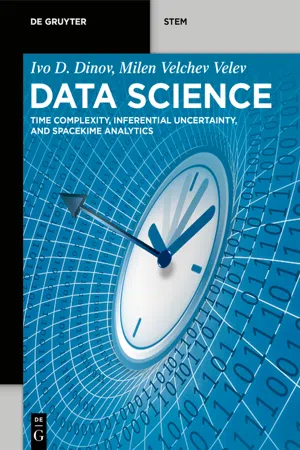
Data Science
Time Complexity, Inferential Uncertainty, and Spacekime Analytics
- 489 pages
- English
- PDF
- Available on iOS & Android
Data Science
Time Complexity, Inferential Uncertainty, and Spacekime Analytics
About this book
The amount of new information is constantly increasing, faster than our ability to fully interpret and utilize it to improve human experiences. Addressing this asymmetry requires novel and revolutionary scientific methods and effective human and artificial intelligence interfaces.
By lifting the concept of time from a positive real number to a 2D complex time ( kime ), this book uncovers a connection between artificial intelligence (AI), data science, and quantum mechanics. It proposes a new mathematical foundation for data science based on raising the 4D spacetime to a higher dimension where longitudinal data (e.g., time-series) are represented as manifolds (e.g., kime-surfaces). This new framework enables the development of innovative data science analytical methods for model-based and model-free scientific inference, derived computed phenotyping, and statistical forecasting. The book provides a transdisciplinary bridge and a pragmatic mechanism to translate quantum mechanical principles, such as particles and wavefunctions, into data science concepts, such as datum and inference-functions. It includes many open mathematical problems that still need to be solved, technological challenges that need to be tackled, and computational statistics algorithms that have to be fully developed and validated.
Spacekime analytics provide mechanisms to effectively handle, process, and interpret large, heterogeneous, and continuously-tracked digital information from multiple sources. The authors propose computational methods, probability model-based techniques, and analytical strategies to estimate, approximate, or simulate the complex time phases (kime directions). This allows transforming time-varying data, such as time-series observations, into higher-dimensional manifolds representing complex-valued and kime-indexed surfaces (kime-surfaces).
The book includes many illustrations of model-based and model-free spacekime analytic techniques applied to economic forecasting, identification of functional brain activation, and high-dimensional cohort phenotyping. Specific case-study examples include unsupervised clustering using the Michigan Consumer Sentiment Index (MCSI), model-based inference using functional magnetic resonance imaging (fMRI) data, and model-free inference using the UK Biobank data archive.
The material includes mathematical, inferential, computational, and philosophical topics such as Heisenberg uncertainty principle and alternative approaches to large sample theory, where a few spacetime observations can be amplified by a series of derived, estimated, or simulated kime-phases. The authors extend Newton-Leibniz calculus of integration and differentiation to the spacekime manifold and discuss possible solutions to some of the "problems of time". The coverage also includes 5D spacekime formulations of classical 4D spacetime mathematical equations describing natural laws of physics, as well as, statistical articulation of spacekime analytics in a Bayesian inference framework.
The steady increase of the volume and complexity of observed and recorded digital information drives the urgent need to develop novel data analytical strategies. Spacekime analytics represents one new data-analytic approach, which provides a mechanism to understand compound phenomena that are observed as multiplex longitudinal processes and computationally tracked by proxy measures. This book may be of interest to academic scholars, graduate students, postdoctoral fellows, artificial intelligence and machine learning engineers, biostatisticians, econometricians, and data analysts. Some of the material may also resonate with philosophers, futurists, astrophysicists, space industry technicians, biomedical researchers, health practitioners, and the general public.
Frequently asked questions
- Essential is ideal for learners and professionals who enjoy exploring a wide range of subjects. Access the Essential Library with 800,000+ trusted titles and best-sellers across business, personal growth, and the humanities. Includes unlimited reading time and Standard Read Aloud voice.
- Complete: Perfect for advanced learners and researchers needing full, unrestricted access. Unlock 1.4M+ books across hundreds of subjects, including academic and specialized titles. The Complete Plan also includes advanced features like Premium Read Aloud and Research Assistant.
Please note we cannot support devices running on iOS 13 and Android 7 or earlier. Learn more about using the app.
Information
Table of contents
- Preface
- Foreword
- Contents
- Use and Disclaimer
- Glossary, Common Notations, and Abbreviations
- Chapter 1 Motivation
- Chapter 2 Mathematics and Physics Foundations
- Chapter 3 Time Complexity
- Chapter 4 Kime-series Modeling and Spacekime Analytics
- Chapter 5 Inferential Uncertainty
- Chapter 6 Applications
- 7 Summary
- References
- Index